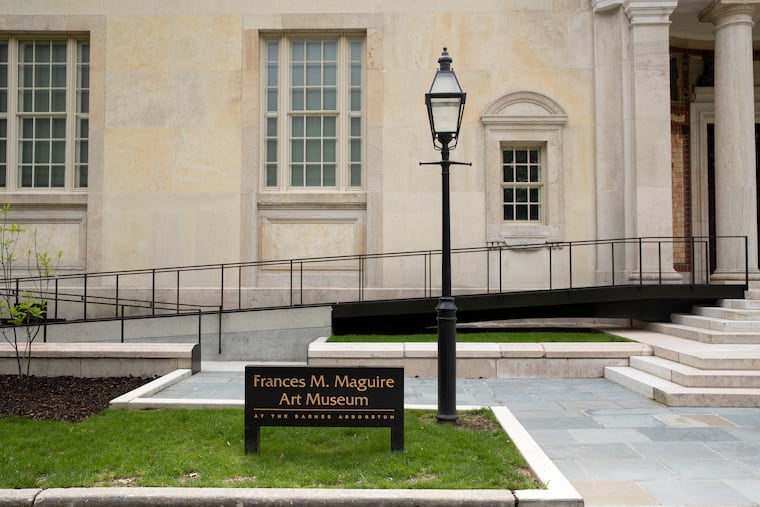The original Barnes Foundation building is re-opening its doors as part of St. Joe’s
The Frances M. Maguire Art Museum sits next to Saint Joseph’s University campus and opens to the public on May 6. Admission is free.

This weekend, the historic building that once held the Barnes Foundation collection will reopen to the public, now as the Frances M. Maguire Art Museum.
“Does the city really need another museum? The answer is yes, if we can collect things that other museums don’t have, and we have done that,” said curator Carmen Croce, who has overseen and expanded St. Joseph’s University’s collection for 55 years. The neighboring school is leasing the original Barnes building and arboretum.
The renovated 15-gallery space in Lower Merion displays the university’s art collection of some 2,500 artworks spanning 3,000 years. The museum will also host rotating exhibits, classes, performances, and more.
The university’s collection, a wide assortment of religious paintings, contemporary art, and historical artifacts, has never been displayed as a whole before, and it’s certainly a contrast from Albert Barnes’ precise layout of Impressionist art that commanded these walls between 1925 and 2011. But these are no longer the same rooms Barnes walked through.
Philadelphia architecture firm DIGSAU knocked down some walls to make bigger gallery rooms, adding doorways to create easier walkways. They also fixed the building’s exterior while preserving its historic facade, and added an accessibility ramp. “It was actually quite complicated, maneuvering all the steps out and sliding a ramp in, in a way that we believe augments the historic quality of the building,” said Jamie Unkefer, a principal at DIGSAU.
Another challenge was procuring the same limestone used in the original building to add to the exterior, which Unkefer and his team tracked down in France. “It was the last stones from the quarry that were originally used for the building,” he said.
On view in the new museum is a significant collection of colonial Latin American art including paintings, sculptures, and textiles from Mexico, the Philippines, and South America dated between the 17th and 19th centuries. Historic sculptures from various African countries, with a focus on Christian art from Ethiopia, are also on view. Then, there are prints and paintings from Japan, India, and China.
Andy Warhol, Salvador Dali, and Romare Bearden share space with Philadelphia artists Paul Keene and Andrew Turner. There are life-size plaster and bronze casts by Michelangelo and others — some gifted and some on loan from the Metropolitan Museum of Art — and a room of 100 stained glass windows.
Each room has a distinct focus, which helps bring clarity to an otherwise scattered vision.
Efforts to reopen the building began in 2018 after the Barnes Foundation leased its former gallery space and arboretum of the same name to St. Joe’s. A year earlier, the university had received a $50 million gift from local philanthropists James and Frances Maguire which helped renovate the museum. The family’s foundation also gifted $10 million recently to expand Chestnut Hill’s Woodmere Art Museum.
The museum is named after Frances, affectionately known as “Frannie,” a painter and beloved figure in Philadelphia’s arts scene who died in 2020. Her portrait of a brooding man, titled Thinker, can be found in the second floor hallway.
For the Maguire family, the museum’s opening is emotional. “This isn’t just money to clean up the building, this is really preserving my mom’s legacy,” said Megan Maguire Nicoletti, Frannie’s daughter, who now runs the Maguire Foundation. “Art was really her way of expressing love, and she wanted especially children in the city of Philadelphia to have access to art.”
“[Frances Maguire’s] interest in making art accessible for the blind, for all of these groups — that really has been a part of our charge,” said Emily Hage, the Maguire Art Museum director who also teaches art history at St. Joe’s. “Art needs to be accessible and it is relevant to everything, and that’s what’s nice about being a university museum is that we have all of these experts, these faculty, students, staff … we can harness that to make ourselves relevant and to show how relevant art is.”
Much of the artwork in St. Joe’s permanent collection is rooted in religious practices across many cultures and generations. “Black | Communion: Philadelphia Artists,” an exhibit in the teaching gallery curated by a professor-student duo, examines photography, painting, and sculpture by Black Philadelphians from the 1930s to present day.
“Shifting Ecologies: Contemporary Artists and the Environment” is the museum’s first temporary exhibit, showcasing 15 artists, including many from the region.
Fort Lee, N.J.-based Tai Hwa Goh created honeycomb-shaped wax paper designs that mimic flowers and placed them in the spouts of plastic or metal pipes. Also protruding from the gallery walls is Gratitude Code Root Mural, a striking sculpture by Brooklyn-based Indigenous artist Jude Norris, who also goes by the name Bebonkwe. The exhibit runs through June 25.
The Maguire Art Museum is located at 50 Lapsley Lane, Lower Merion, and officially opens May 6. The museum will be open on subsequent weekends 11 a.m. to 4 p.m. from Thursday through Saturday. Admission is free, though there is a suggested donation of $10.